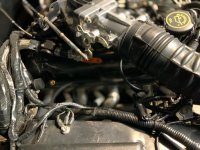I always thought that a clean ground to the frame was the best way to ground the battery.
Nope, not really. At least not without some variation on that theme.
The engine is where the biggest load (the starter) is.
It's not a bad thing to ground the frame, and I'm pretty sure older vehicles would ground the frame and engine to the same location. Older vehicles often used one of those wide, flat braided grounding straps that had the boss in the middle that was used to ground the frame or the body, then the other end continued on to the engine.
So grounding the frame is fine and a time honored practice. And maybe even where you got the idea from? But should only be
in addition to the engine block. Not instead of.
Remember that in reality very few things are using the frame as their grounding point. It's just a convenient bit of metal that can be used as such. Only light duty things like the fuel sender or maybe two or three other things use the frame as ground. So if you use exclusively the frame, your starter motor is not getting the full juice because the current is trying to find it's way through rubber engine and trans mounts mounts.
It does of course, because there are plenty of bolts from metal to metal. But it's not always close and not the best way to pass that heavy current the starter needs.
So if you do use your frame as the main grounding point (or just want to keep your existing wiring), then you must run an additional ground cable from that same point on the frame over to the engine. This effectively connects the battery negative to the engine block, so the starter gets it's due.
And so that the ground wire between the engine and the cab/firewall takes full benefit as well.
I’m running a 100 amp alternator, do you believe that the low amp alternator would cause those low voltage errors?
No. Not usually.
First, if you see 14 at the battery you are not running low voltage. However if the code is an old one from when you were not getting the full 14.5v while driving, then yes absolutely it could be the cause.
But it's not the 100a capacity. A normal engine can run on just the little old 55a alternators. Just not very effectively or consistently. And consistency is what the engine computer wants. Hence the droning on about proper grounding, large enough wires and battery cables, and a good alternator.
The advantage of a 3g is it's simplicity, steady output including high output at low engine speeds like idling, but that 95 to 130 amp capability gives the system a lot of headroom. At 100+ amps your alternator has a long way to deteriorate before the computer starts getting wonky. A 40a alternator on the other hand has nowhere to go. If it starts to get older or the connections get corroded, it falls below the threshold quickly.
Modern alternators need that much juice not just to handle all the accessories, but to keep the computer from seeing low voltage when you're idling with everything running. You don't want the engine to cough just because you have the heater on while idling in the snow.
So your 100a is more than plenty. But you need to make sure it's capable of putting that much out if needed. Maybe have it tested if you ever happen to take it off the engine for whatever reason. It would suck to find out it's only capable of putting out 50a max, but would suck even more if you had to deal with it and never checked.
Steve / Paul I’m not sure exactly how to post with my sig as you mentioned above?
In the User CP (command post) up above to the left you can go in and change your personal settings. Somewhere in that menu of things you can do is a "change your signature" or something along those lines. Whatever you add to that will then show in your posts every time.
Paul





















